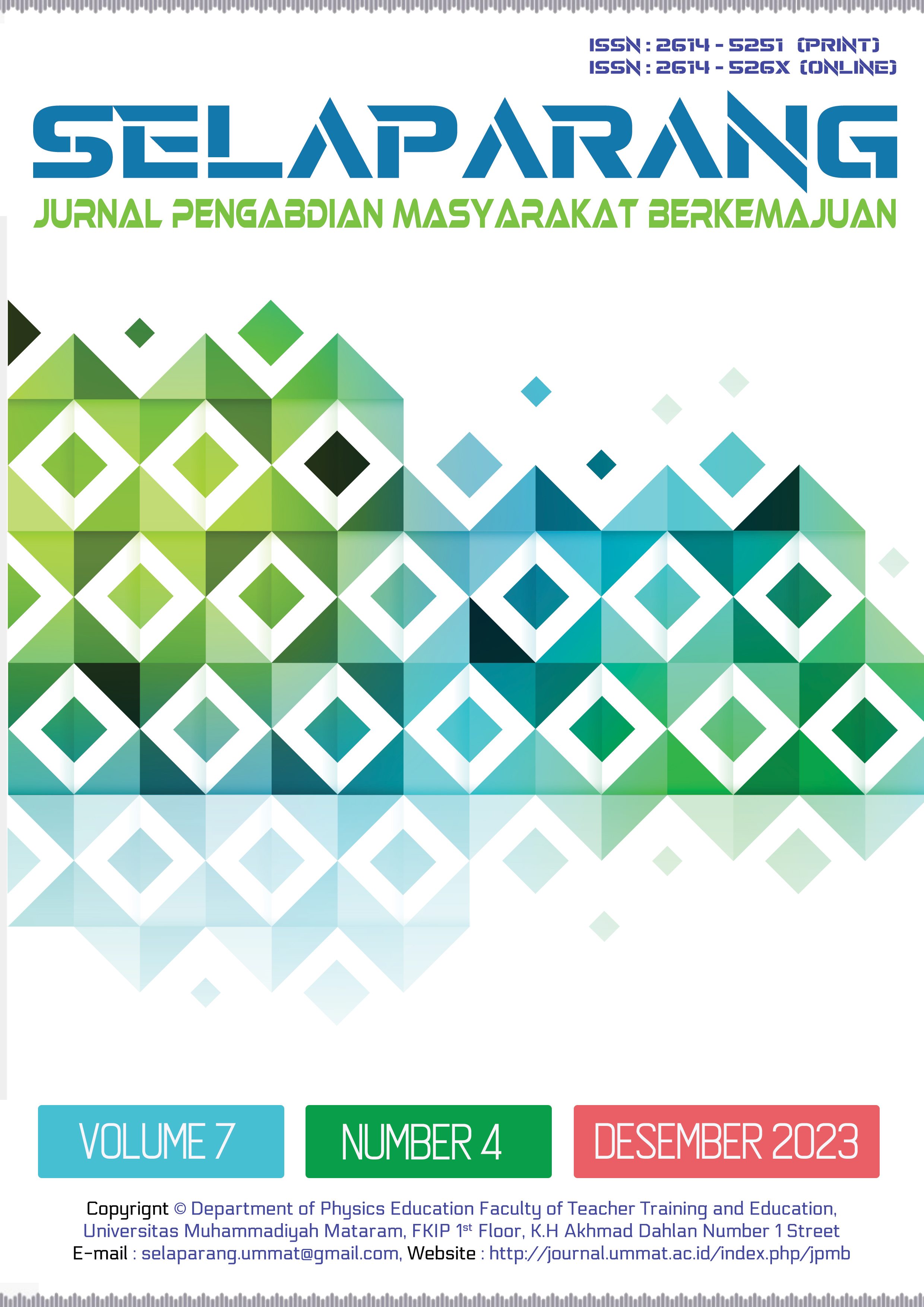SKRINING KESEHATAN MENTAL IBU MELALUI INSTRUMEN EDINBURG POSTNATAL DEPPRESSION SCALE (EPDS) SEBAGAI UPAYA PENCEGAHAN DEPRESI PASCAPERSALINAN
DOI:
https://doi.org/10.31764/jpmb.v7i4.14593Keywords:
devotion, postpartum, screening, mental healthAbstract
ABSTRAK
Skrining depresi deteksi dini dan penatalaksanaan depresi masa hami sampai pascapersalinan. Tujuan pengabdian ini untuk melakukan skrining kesehatan mental ibu melalui instrument edinburg postnatal depression scale (EPDS). Metode pelaksaan pengabdian ini mengadopsi langkah-langkah action research yang terdiri dari 4 (empat) tahapan, yaitu: perencanaan, tindakan, observasi dan evaluasi, dan refleksi. Hasil kegiatan pengabdian ini sebelum diberikan informasi terkait kesehatan mental masa nifas sebanyak 10 ibu nifas belum mengetahui pengertian, jenis gangguan kesehatan mental, gejala dan penatalaksanaan gangguan kesehatan mental. Setelah diberikan informasi kesehatan mental sebanyak 10 ibu nifas menjawab dengan benar. Berdasarkan hasil skrining didapatkan 9 ibu nifas dalam kategori tidak depresi dan 1 ibu nifas dalam kategori kategori depresi ringan.
Â
Kata kunci: pengabdian; ibu nifas; skrining; kesehatan mental
Â
ABSTRACT
Depression early detection and management of depression during pregnancy to postpartum. The purpose of this service is to screen mothers' mental health through the Edinburgh Postnatal Depression Scale (EPDS) instrument. This service implementation method adopts action research steps which consist of 4 (four) stages, namely: planning, action, observation and evaluation, and reflection. The results of this service activity before being given information related to postpartum mental health as many as 10 postpartum mothers did not know the meaning, types of mental health disorders, symptoms and management of mental health disorders. After being given mental health information, 10 postpartum mothers answered correctly. Based on the screening results, 9 postpartum mothers were in the non-depressed category and 1 postpartum mother was in the mild depression category.
Â
Keywords: devotion; postpartum; screening; mental health
References
Adli, F. K. (2022) ‘Edinburgh Post-natal Depression Scale (EPDS): Deteksi Dini dan Skrining Depresi Post-partum’, Jurnal Kesehatan, 13(2), pp. 430–436. doi: 10.26630/JK.V13I2.2741.
Dennis, C. L., Falah-Hassani, K. and Shiri, R. (2017) ‘Prevalence of antenatal and postnatal anxiety: systematic review and meta-analysis’, The British journal of psychiatry : the journal of mental science, 210(5), pp. 315–323. doi: 10.1192/BJP.BP.116.187179.
Desiana, W. and Tarsikah, T. (2021) ‘Screening of Post Partum Depression on the Seventh Day Puerperium’, Indonesian Midwifery and Health Sciences Journal, 5(2), pp. 198–208. doi: 10.20473/imhsj.v5i2.2021.198-208.
Doucet, S., Letourneau, N. and Blackmore, E. R. (2012) ‘Support needs of mothers who experience postpartum psychosis and their partners’, Journal of obstetric, gynecologic, and neonatal nursing : JOGNN, 41(2), pp. 236–245. doi: 10.1111/J.1552-6909.2011.01329.X.
Falah-Hassani, K., Shiri, R. and Dennis, C. L. (2016) ‘Prevalence and risk factors for comorbid postpartum depressive symptomatology and anxiety’, Journal of affective disorders, 198, pp. 142–147. doi: 10.1016/J.JAD.2016.03.010.
Farr, S. L. et al. (2014) ‘Postpartum anxiety and comorbid depression in a population-based sample of women’, Journal of women’s health (2002), 23(2), pp. 120–128. doi: 10.1089/JWH.2013.4438.
Healey, C. et al. (2013) ‘Self-harm in postpartum depression and referrals to a perinatal mental health team: an audit study’, Archives of Women’s Mental Health, 16(3), p. 237. doi: 10.1007/S00737-013-0335-1.
Hutchens, B. F. and Kearney, J. (2020) ‘Risk Factors for Postpartum Depression: An Umbrella Review’, Journal of Midwifery & Women’s Health, 65(1), pp. 96–108. doi: 10.1111/JMWH.13067.
Jonsdottir, S. S. et al. (2017) ‘Partner relationship, social support and perinatal distress among pregnant Icelandic women’, Women and Birth, 30(1), pp. e46–e55. doi: 10.1016/J.WOMBI.2016.08.005.
Kingston, D., Tough, S. and Whitfield, H. (2012) ‘Prenatal and postpartum maternal psychological distress and infant development: a systematic review’, Child psychiatry and human development, 43(5), pp. 683–714. doi: 10.1007/S10578-012-0291-4.
Luh, N. I. and Sri, A. Y. U. (2023) ‘DETEKSI DINI DEPRESI POSTPARTUM PADA IBU NIFAS DENGAN MENGGUNAKAN FORM EDINBURGH POSTNATAL DEPRESSION SCALE ( EPDS ) DI RSUD BALI MANDARA PROGRAM STUDI SARJANA KEBIDANAN PROGRAM B’.
Mughal, M. K. et al. (2019) ‘Trajectories of maternal distress and risk of child developmental delays: Findings from the All Our Families (AOF) pregnancy cohort’, Journal of affective disorders, 248, pp. 1–12. doi: 10.1016/J.JAD.2018.12.132.
Netsi, E. et al. (2018) ‘Association of Persistent and Severe Postnatal Depression With Child Outcomes’, JAMA psychiatry, 75(3), pp. 247–253. doi: 10.1001/JAMAPSYCHIATRY.2017.4363.
Ohrnberger, J., Fichera, E. and Sutton, M. (2017) ‘The relationship between physical and mental health: A mediation analysis’, Social science & medicine (1982), 195, pp. 42–49. doi: 10.1016/J.SOCSCIMED.2017.11.008.
Polte, C. et al. (2019) ‘Impact of Maternal Perinatal Anxiety on Social-Emotional Development of 2-Year-Olds, A Prospective Study of Norwegian Mothers and Their Offspring : The Impact of Perinatal Anxiety on Child Development’, Maternal and child health journal, 23(3), pp. 386–396. doi: 10.1007/S10995-018-2684-X.
Putriarsih, R., Budihastuti, U. R. and Murti, B. (2017) ‘Prevalence and Determinants of Postpartum Depression in Sukoharjo District, Central Java’, Journal of Maternal and Child Health, 03(01), pp. 395–408. doi: 10.26911/thejmch.2017.03.01.02.
Yaumi, Muhammad dan Damopolii, M. (2014) Action Research : Teori, Model, dan Aplikasi. Jakarta: Kencana.
van der Zee-van den Berg, A. I. et al. (2021) ‘Postpartum depression and anxiety: a community-based study on risk factors before, during and after pregnancy’, Journal of Affective Disorders, 286(January), pp. 158–165. doi: 10.1016/j.jad.2021.02.062.
Downloads
Published
Issue
Section
License
The copyright of the received article shall be assigned to the journal as the publisher of the journal. The intended copyright includes the right to publish the article in various forms (including reprints). The journal maintains the publishing rights to the published articles.

Selaparang : Jurnal Pengabdian Masyarakat Berkemajuan is licensed under a Creative Commons Attribution-ShareAlike 4.0 International License.

